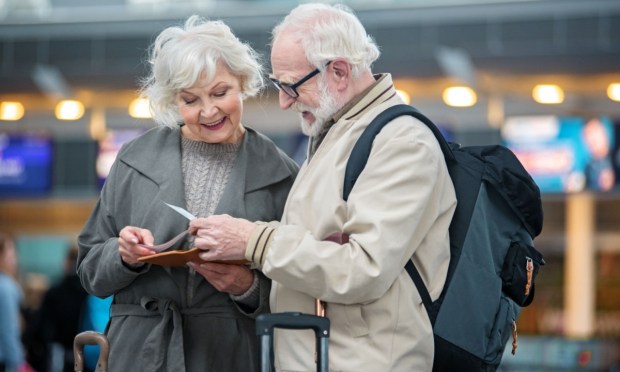New Q1 Data Finds Older Demographics Driving Surge in Travel Spend

They’re probably not going to Paris to see Taylor Swift. But spending among older, high-income consumers has led a Q1 travel surge that cuts across income and age boundaries, even if “Swiftonomics” isn’t part of the trend.
A deep dive into PYMNTS Intelligence’s most recent “Last Transactions“ analysis of Q1 consumer spending patterns shows an uptick among all age groups in the travel category, with credit card usage getting a 24% bump over Q4. It is the older (44+), high-income ($100,000+) consumers who consistently outspend their younger counterparts and those in lower income brackets.
By the numbers, older, high-income consumers are on pace to match their Q1 levels of $1,202.10 spent on travel via credit card. That number plunged to $654 during Q2 of 2023 and has now rebounded to $1061.30.
Younger, high-income consumers credit spend on travel has come from a Q4 2022 level of $222.50 to $413.30 in Q1. On the low-income end of the spectrum (less than $100,000) older consumers exponentially increased their spend from a low of $39.70 in Q3 2023 to Q1’s $341.30. Younger low-income consumers have seen an increase from their average low of $106.20 in Q3 2023 to $184.11 in Q1.
What’s driving these trends? PYMNTS Intelligence’s take is that the older demographic’s willingness to use credit cards for travel purchases highlights their trust in credit providers, many of which offer protections against canceled trips and fraudulent charges.
“The difference in spending could also be attributed to varying priorities, financial strategies, or available leisure time, with many older consumers being retired and having more flexibility to travel,” the PYMNTS Intelligence report said.
Within these dynamics — and in considering new ones — there are other clues to the surge in travel spend:
Business travel: Business travel spending has seen a significant increase in recent months, particularly among global multinational companies.
As seen in PYMNTS, according to American Express Global Business Travel (Amex GBT), larger corporations outpaced the growth in travel by small- to medium-sized businesses (SMBs) for the first time since the recovery from the pandemic.
During the first quarter, Amex GBT reported an 11% year-over-year increase in transaction growth for global multinationals, compared to a 5% rise for SMBs. This growth was particularly evident in sectors such as technology, professional services, pharmaceuticals, mining, energy and utilities.
Airlines like Delta, United and Alaska Airlines have also reported a rebound in corporate travel, with bookings reaching or exceeding pre-pandemic levels. Increased spending by tech companies, coupled with a more optimistic economic outlook and a return to office work, has contributed to this growth. As a result, airline executives expect the demand for business travel to continue growing in the coming months.
Card-Linked Offers: A recent PYMNTS Intelligence research study, conducted in collaboration with Banyan, showed that travel credit cards are becoming increasingly popular among consumers, particularly those with children.
The study found that nearly 64% of consumers are likely to use card-linked offers (CLOs) for local travel purchases in the next three months, while 60% plan to do the same for long-distance travel purchases. These figures highlight the growing importance of travel credit cards, which offer a range of perks, including free travel tickets, discounted baggage fees, rental car discounts and free travel insurance.
The intention to use CLOs for travel purchases is even higher among consumers with children under care, with a 38% increase for long-distance travel and a 30% increase for local travel benefits compared to those without children. The study also found that travel is a top consumer choice when using CLOs, surpassing other categories such as groceries, streaming subscription services and personal wellness.
As a result, travel industry merchants who leverage item-level receipt data to offer targeted CLOs may be able to gain a competitive edge in the market and drive increased customer engagement and loyalty.
Buy Now, Pay Later: Another recent report from PYMNTS Intelligence, in collaboration with Splitit, adds some color to the travel surge as well. It found that three in five consumers said they’d used some split-payment option at least once in the last year across all categories, with 37% of consumers saying they had used BNPL. More than a third had used BNPL to buy clothes and accessories, 18% had done so with groceries and more than 14% had chosen BNPL when paying for travel-related services.
Loyalty programs: Recent reports show that rewards programs in the travel space have become more aggressive and could be driving more consumer travel. A 2023 survey on travel loyalty from travel technology company Arrivia showed a a significant shift in program goals from member acquisition and retention to profitability, with a focus on encouraging members to move up tiers, increase spending and introduce new rewards or redemption options.
